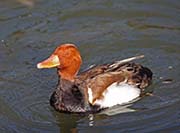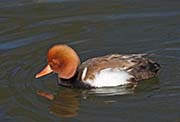Red-crested Pochard - Netta rufina
| Length | |
| Wingspan | |
| Clutch Size | |
| Chicks at birth | |
| IUCN Conservation Status | |
Continents: |
The Red-crested Pochard is a large diving duck that is found throughout Europe, Asia, and northern Africa. They are considered social birds, and will form large flocks in the winter. They are also the most active early in the morning and evening.
Red-crested Pochards are sexually dimorphic. The male, in breeding plumage, has a rounded orange head, the breast, underparts, tail are black and the flanks are white. The wings are brown with a white leading edge. The secondaries and primaries are white with dark tips. The bill and iris are red and the legs and feet are orangish. The male's eclipse plumage is similar to the female's plumage, except his bill and iris are still red.
The female's body is mostly shades of brown, lighter on the underparts. The head and upper neck is a darker brown and the throat and face are whitish gray. The bill is grayish brown with some red, especially at the tip. The iris is red-brown and the legs and feet are pinkish. Juveniles are similar to adult females.
Diet: White a diving duck, Red-crested Pochards also 'dabble' or up-end for food. They also do not dive deeply for food. Their diet is almost totally vegetation such as roots, seeds and green parts of aquatic plants. They may also eat some mollusks.
Courtship: Males courtship behavior and precopulatory behavior includes sneezing, head-flicking, preening behind the wing, and bill dipping. Many sources report that they are the only Pochards that have courtship feeding in which the male dives for vegetation which the female then eats on the surface.
Nesting: The nest is built on the ground in thick vegetation near water. The nest consists of roots, twigs and leaves and is lined with down. The eggs are pale green. Sometimes the female is parasitic and will lay her eggs in other bird's nests. The female does all the incubation.
Habitat and Range: Red-crested Pochards breed in lowland marshes and lakes throughout parts of Europe, Asia and northern Africa. They are considered partially migratory.
Vocalization: Some vocalization is part of the courtship and breeding rituals by both sexes. Otherwise, they are not considered a vocal bird.
Plumage/Molt: The male has both a breeding and an eclipse plumage.
Migration: Partially migratory.
Tongue/feet: Males legs and feet are red and females are pinkish.
Bibliography:
- del Hoyo, Josep, Elliott, Andrew, Sargatal, Jordi, et.al., Handbook of the Birds of the World,Lynx Edicions
- Johnsgard, Paul, Ducks, Geese, and Swans of the World,University of Nebraska-Lincoln Press, 1978
- http://en.wikipedia.org The Free Encyclopedia, Accessed January, 2014





